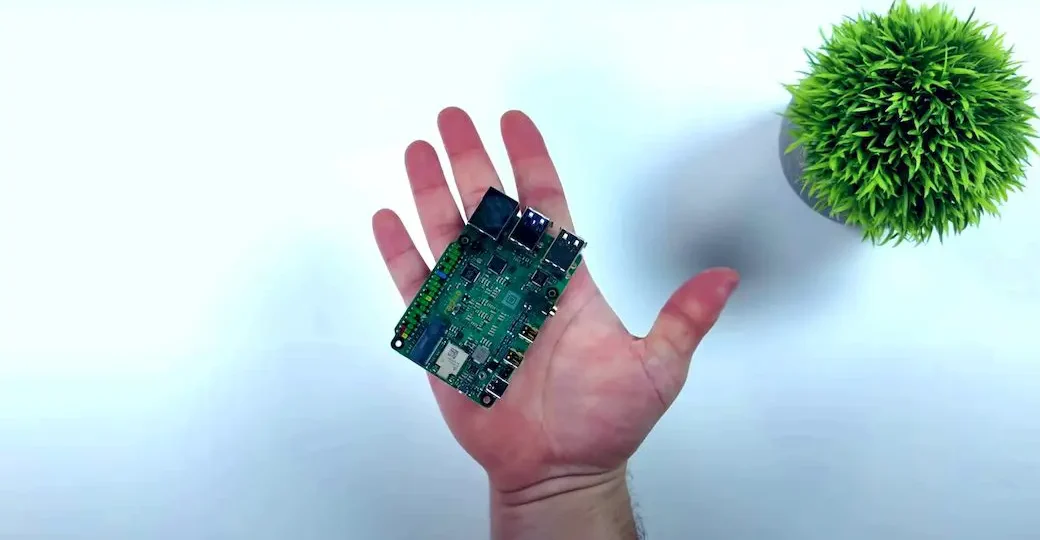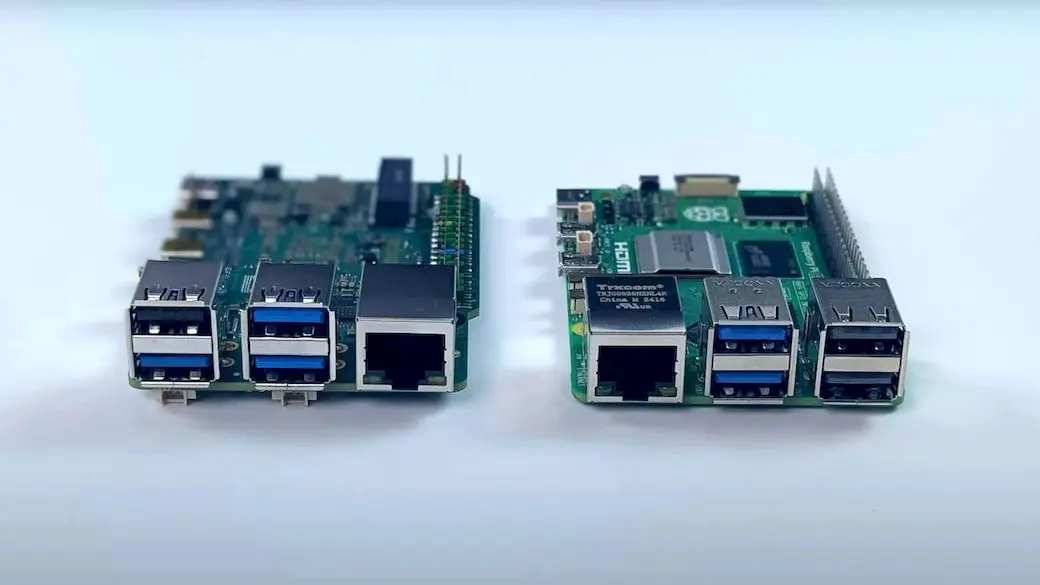A PC That Fits in Your Pocket! Radax X4 Hands-On First Look
September 9, 2024 | by Smith Elsie

Hey everyone, it’s ETA Prime back again, and today, we’ll be taking a closer look at the Radax X4, a recently released x86 single-board computer (SBC) that is incredibly powerful for its small size. You’ll enjoy what the Radax X4 has to offer if you’re familiar with SBCs like the Raspberry Pi, especially if you’re searching for an easy-to-use x86 option that can run Linux or Windows.
Super Compact Design
The Radax X4’s physical factor will catch your attention right away because it resembles a Raspberry Pi 4 or 5. It’s important to note that it shares the same 40-pin GPIO header, especially if you’re working on projects that require Pi accessories. But its x86 architecture, which is driven by an Intel N100 CPU, is what really stands out in this case. Because of this, the X4 can now run full versions of Linux and Windows distributions, transforming it into a portable, powerful mini-PC.
Two Variants for Different Needs
There are two RAM versions of the X4 available from Radax: 4GB and 8GB. For quicker wireless access, the 8GB model also comes with Wi-Fi 6 and Bluetooth 5.2. Wi-Fi 5 is included on the base model with 4GB RAM, and both variants provide choices for eMMC storage. You can add your own M.2 SSD to a barebones setup, like I did, if you want to save a little cash.
Another noteworthy feature is pricing: an 8GB device without eMMC storage costs $80, while a 4GB variant starts at just $60. For an additional $9–$10, you may upgrade to 32GB or 64GB eMMC modules if you desire built-in storage. Even when compared to SBCs based on ARM, the X4 is quite competitive in terms of price-to-performance ratio.
Impressive I/O
Moreover, the Radax X4 doesn’t cut corners with connectivity. What you get is this:
- 2.5GB Ethernet for super-fast wired internet
- Three USB 3.2 ports and one USB 2.0 port
- Dual micro HDMI ports, supporting up to 4K resolution (although no CEC support if you’re thinking of using it for a media center)
- USB Type-C for power input
- A 3.5mm audio combo jack
- A 2230 M.2 SSD slot for storage expansion
Additionally, it supports RTC batteries and has a fan header, which makes it perfect for low-power embedded applications. Additionally, since the Intel N100 CPU is located at the bottom of the board, cooling is required. Fortunately, Radax offers an official X4 cooler that functions well.
Performance Testing
I loaded Windows 11 Pro on a 512GB M.2 SSD that I took out of a Steam Deck and used to set up the Radax X4. Although I had to get the Wi-Fi drivers from the official website in order to get it up and running, the installation process was simple.
The integrated Intel UHD graphics can clock up to 750MHz, while the N100 CPU has four cores and four threads with a maximum boost frequency of 3.4GHz. This computer is more than capable for routine desktop duties like online browsing, office applications, and media streaming, even though it’s by no means a gaming rig.
It should be noted that although the CPU has a low TDP rating, the system can consume up to 21 watts when it is operating at maximum load. Fortunately, the integrated heatsink and aluminum casing keep things cool, and I didn’t notice any thermal throttling even when I was taxing the CPU. The X4 can operate at its best for longer thanks to the greater TDP, which is fantastic if you need a little extra power.
Everyday Usability
Real-world performance-wise, the Radax X4 manages Windows 11 rather well. Simple productivity tasks function flawlessly, and multitasking is surprisingly seamless for a little tablet because to the 8GB of LPDDR5 RAM. For heavier tasks, I did wish there was a 16GB option, but 8GB should be more than enough for most consumers.
The two micro HDMI ports support 4K output on both displays for media playing; nevertheless, some customers who want to utilize this as a media center may find it lacking in HDMI CEC. Nevertheless, it’s a fantastic choice for light media consumption, and it could easily be used as a home server or a small desktop substitute for business.
For the average Windows user, this $80 single-board computer (SBC) may provide fairly good performance if your main tasks are online browsing, email checking, document writing, and light photo editing with programs like GIMP. It performs admirably on ordinary chores but falls short in more taxing activities like gaming and emulation. This is mostly because of its 8GB of RAM, which also serves as shared VRAM.
Performance Overview
For Daily Use: The SBC offers sufficient performance for common applications. It is easy to use for a variety of tasks, including web browsing, email management, document editing, and light photo editing. Despite being small, the 8GB of RAM provides good assistance for these tasks. However, with increasingly resource-intensive applications, the system begins to age.
Gaming and Emulation: The SBC’s limitations are evident in terms of gaming and emulation. With only 8GB of RAM, the system frequently overflows swap space when playing more demanding games, which causes lag and poor performance. This indicates that the SBC has trouble with games that require a lot of resources, but it can manage games that are less demanding rather easily.
For example, Dirt 3 works nicely at 900p medium settings, whereas Hades 2 runs smoothly at 1080p low settings. Nevertheless, intensive games such as Cyberpunk 2077 exhibit performance issues even at 720p on the lowest settings, underscoring the limitations of the 8GB RAM configuration. Older games like as Left 4 Dead 2 manage to run at 900p on medium settings, but the frame rate is not as good as expected.
Emulation: This is where the SBC really comes into its own and shines. It runs PSP games at 4X resolution with no problems using PPSSPP. Similarly, the Dolphin emulator allows for flawless 720p gameplay on GameCube titles like Automobilista. However, you might need to change the settings to native resolution for harder GameCube games like F-Zero GX. Playing PS2 games on PCSX2 at 1.5x resolution is also doable, however more demanding games could require reducing performance.
4K Video Playback
Capable of handling 4K video playback, this SBC is one of its best characteristics. Being able to play 4K HDR video at 60 frames per second without experiencing any missed frames thanks to the N100 chip makes it a great option for a media player. Nevertheless, customers who require support for HDMI Audio Return Channel (ARC) may find this to be a disadvantage. In terms of networking, it can fully exploit a gigabit Ethernet connection and achieves impressive speeds with Wi-Fi 6.
Storage and Performance Benchmarks
Although it’s not the fastest SSD available, the PCIe 3.0 SSD that comes with the SBC is fast enough for a system this size. Geekbench 6 gives the N100 an excellent single-core score of 1,156 and a multi-core score of 2,922 when it comes to performance benchmarks.
Power Consumption
The SBC’s power efficiency is noteworthy. When not in use, it consumes just 4 watts, but when gaming or emulating heavily, it peaks at 26 watts. Because of this, it can be used for a variety of energy-efficient tasks, ranging from standard computing to more complex applications.
Conclusion
Due to its bigger form design and higher cooling requirements, this SBC is not a straight substitute for the Raspberry Pi, but it still offers a great bargain for anyone wishing to build a media center, everyday desktop, or tiny emulator. The 8GB model without eMMC costs $80, making it an attractive option for those looking for a reasonably priced but feature-rich system. Please feel free to post a remark or contact us for further information if you’re interested in learning more about its possibilities, such as running Linux or testing other apps.
Video review of Radax X4
RELATED POSTS
View all







